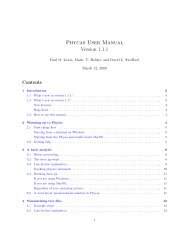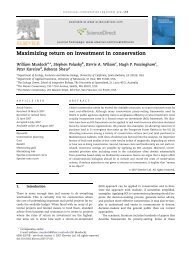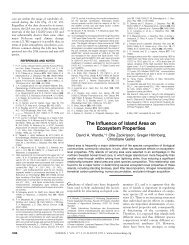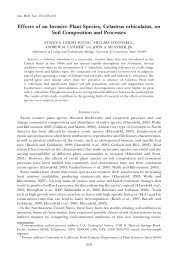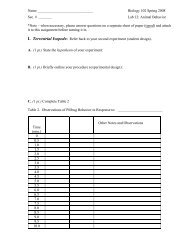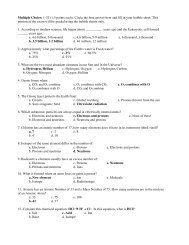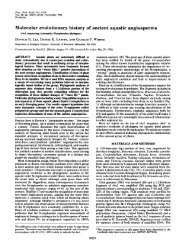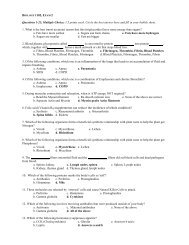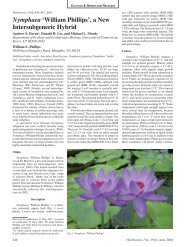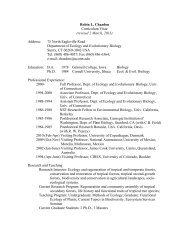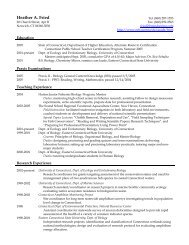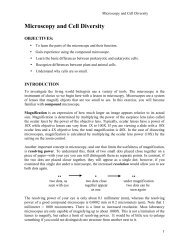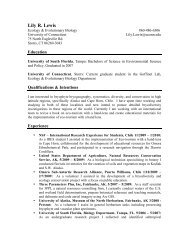Microscopy and Cell Diversity Lab Make-Up Name: Biology 1102 ...
Microscopy and Cell Diversity Lab Make-Up Name: Biology 1102 ...
Microscopy and Cell Diversity Lab Make-Up Name: Biology 1102 ...
You also want an ePaper? Increase the reach of your titles
YUMPU automatically turns print PDFs into web optimized ePapers that Google loves.
<strong>Microscopy</strong> <strong>and</strong> <strong>Cell</strong> <strong>Diversity</strong> <strong>Lab</strong> <strong>Make</strong>-<strong>Up</strong><br />
<strong>Biology</strong> <strong>1102</strong><br />
<strong>Name</strong>: ________________________<br />
Section: __________<br />
This exercise replaces your quiz <strong>and</strong> homework grade for the Introduction to <strong>Microscopy</strong> <strong>and</strong><br />
Introduction to <strong>Cell</strong> <strong>Diversity</strong> lab. First read through these two sections of your lab manual to<br />
familiarize yourself with the concepts <strong>and</strong> terminology. Most of the following questions require<br />
you to look up information either in your lab manual, textbook, or on a website. Your answers<br />
must be complete, well thought out, <strong>and</strong> in your own words. Type your answers on a separate<br />
sheet of paper, <strong>and</strong> leave space for your drawings. You may make your drawings on separate<br />
sheets <strong>and</strong> attach them, but you must clearly identify each drawing with the question number <strong>and</strong><br />
a name label. If you have any questions, feel free to contact your TA.<br />
1. (1/2 pt) How would you determine the magnification of an object you are viewing in the<br />
compound microscope<br />
2. (1/2 pt) Describe what you would do when you have finished using your microscope in<br />
lab (you will be using them in future labs).<br />
3. (1 pt) <strong>Name</strong> two main differences between prokaryotic <strong>and</strong> eukaryotic cells. <strong>Name</strong> one<br />
example from each group.<br />
For questions 4 <strong>and</strong> 5, refer to this website:<br />
http://www.biology.arizona.edu/cell_bio/tutorials/pev/page2.html<br />
4. (1/2 pt) Are bacterial cells prokaryotes or eukaryotes<br />
5. (1/2 pt) List three interesting characteristics of bacteria.<br />
6. (1 pt) What is gram staining useful for Which color is positive <strong>and</strong> which is negative<br />
For questions 7 <strong>and</strong> 8, refer to this website: http://waynesword.palomar.edu/lmexer1.htm<br />
7. (1/2 pt) Find <strong>and</strong> draw the image of Elodea, a plant cell. <strong>Lab</strong>el the cell wall, cytoplasm,<br />
<strong>and</strong> chloroplasts.<br />
8. (1 pt) Find <strong>and</strong> draw the image of human cheek cells, an example of animal cells. <strong>Lab</strong>el the<br />
cell membrane, nucleus, <strong>and</strong> cytoplasm.<br />
9. (1/2 pt) Find out why methylene blue stain is used to look at some cells under a microscope.<br />
(The answer is simple, don’t get yourself bogged down in an entire chemistry lesson. Cite<br />
your source if you use the internet.)<br />
10. (1 pt) <strong>Name</strong> at least three structural differences between animal cells <strong>and</strong> plant cells.
11. (1 pt) Use your lab manual, a textbook, or an internet source (cite your references!) to<br />
briefly describe each type of cell motility seen in single-celled organisms:<br />
a) pseudopodia<br />
b) cilia<br />
c) flagella<br />
12. (1/2 pt) Go to this website: www.infovisual.info/02/001_en.html<br />
Use the image on this website as a model to draw a Euglena. What is Euglena’s form of<br />
motility<br />
13. Go to this website: www.micro.magnet.fsu.edu/moviegallery/pondscum.html<br />
a) (1/2 pt) Click on “Amoeba,” <strong>and</strong> watch video number 3. Draw an Amoeba. What is<br />
Amoeba’s form of motility<br />
b) (1/2 pt) Click on “Stentor,” <strong>and</strong> watch video number 2. Draw an Stentor. What is<br />
Stentor’s form of motility<br />
Note: These videos are very cool -- you might want to look at more than just these two.<br />
14. (1 pt) Listed below are some cell structures you’ve examined. Match the function of each<br />
from the choices below:<br />
________ <strong>Cell</strong> membrane<br />
________ Nucleus<br />
________ Flagellum<br />
________ Vacuole<br />
a. allows for storage inside the cell<br />
b. hair-like structure that provides motility<br />
c. regulates passage of substances in <strong>and</strong> out of the cell<br />
d. contains genetic information in the form of DNA<br />
To answer the questions below, utilize your manual as well as the following website:<br />
www.microscopy-uk.org.uk/mag/artmar03/rhtermite.html.<br />
15. (1/2 pt) Draw the magnified image of Trichonympha.<br />
16. (1/2 pt) Is Trichonympha flagellate or ciliate<br />
17. (1/2 pt) Is Trichonympha a eukaryote or prokaryote<br />
18. (1 pt) What is mutualism<br />
19. (1 pt) How does a termite benefit from having protozoa like Trichonympha living in its<br />
hindgut, AND what do the protozoa get out of living there<br />
20. (1 pt) How does Trichonympha digest cellulose




